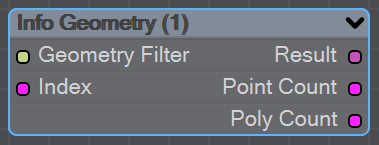Node Reference
Last modified: 10 March 2025Add Geometry

If a name is not provided here the bin's name will be the same as the input geometry.
Weld will collapse the input geometry into one object and remove duplicate vertices.
Add Instance

Boolean CSG

Branch

New to 2024, the Branch Geometry node can be used to make all sorts of branches - from flowers and trees to lightning. The Position tab is for setting the initial disposition of your branch in a line between Position 1 and Position 2, with envelopes for animating those values over time. While the node has a vector input for Noise, you can also purely use the Branching tab. You have control over how many splits there will be, when they will take place, etc. The Mesh tab is for deciding whether your branch will use geometry or rely on edge rendering effects.
Cache Geometry

Options
Combine Geometry

Data Geometry

Evaluate Geometry

Extrude Geometry

Options
- Inset
The distance to bring newly-extruded polygons from the bounds of the original polygon being extruded. Can be animated and textured
- Keep Selection
Checkbox to keep the polygons selected with the Select Polygon node further downstream in node connections
- New Surface
Dropdown with four choices:
New Polygons - Only polygons created with the extrude will get new surfacing. Essentially, the sides of the extrude
Original Polygons - Resurfaces the original polygons from which the extrusion was made. Essentially the top of the extrude
Both - Surfaces original and extruded polygons the same way
None - Has no impact on surfaces

Filter Geometry

For Loop


From Mesh
The From Mesh node will take existing mesh-based objects and use them in a Procedural Geometry context. Objects can be transformed or have additional options like MDD point caches or being categorised as Static. New to 2024, the dropdown menu now contains a Load Mesh entry.
Geometry VDB
This node converts Procedural Geometry objects into VDB objects. The output node for this node requires nodes from the OpenVDB group to continue operations before using the VDB Geometry node to continue as Procedural Geometry geometry.
You can control over Voxel Size (basically the resolution of the object) and Inner and Outer Bandwidths for objects that might not have a consistent amount of detail.
Grid Geometry

Options
Hyper Paint
There are two outputs for this node, Result and Stroke Count. Stroke Count should go to the End input on the For Loop node and Result goes to the Geometry Filter input on the Info Geometry node.

tip
If you turn off keyframes, your stroke will be immediately visible. If you use keyframes you might need to jog the current frame for an update
Info Geometry

The Info Geometry node is most often paired with the Filter Geometry and Data Geometry nodes to extract information about the points, polygons and other details about the geometry it's attached to. Its Geometry Filter input can either be the Filter node's output or directly from Primitive Geometry or Add Geometry node outputs. The Collapse option available on double-clicking the node will output a single mesh, rather than separated components.
L-System
Introduction

Presets


Other settings

Lathe

The Lathe node spins geometry around a chosen axis. You can decide how many turns to make, an offset and whether to close the ends. Lathed geometry can have a distinct surface.
Lerp Vector

Line Geometry


Point Geometry

Poly Geometry

Options
Primitive Geometry

Options
Scatter Points

Select Polygons

Options
Set Position
Set position is used to modify the position of Mesh or Spline geometry in a Procedural Geometry context. The Position Vector input could be supplied by a texture or some other mechanism and the UVBlend scalar input is best fed with a gradient (because they have a built-in UV component).
Spline Geometry

When you double-click on the Spline Geometry node, you will have a choice between Spline and Polyline geometry.
Spline Options
A spline here is a curved line. It has handles at either end to control the tangent. Additional knots can be placed by right-clicking on a knot.
Polyline Options
A polyline is a set of straight edges, much as though you are creating this polygonally. Again, additional knots can be placed by right-clicking a knot
Shared Controls
- Rotate
Rotate the items you are using along the spline about the spline. Using Y Up ghosts this option
- Output
A dropdown with four styles of spline or Polyline to choose from:
Points - Converts the user-created knots and Segments into points
Skin -The main option and the reason for the radius setting.
Knots - Uses the user-created knots and automatic tangential knots
Line Chain - Converts the Polyline into a chain of 2-point polygons
Gizmo

Menu

Rotate and scale

Visualization

Transform Path

Spline Info

Thicken

Thicken makes a shell offset of your mesh with few controls. The offset determines how thick the wall will be and you can offset outwards with a positive value or inward with a negative value; this can be enveloped. The New Surface choice is the same as with Extrude Geometry.
Transform Item
Used to transform (change position, rotation or scale) an item in a Procedural Geometry network.
VDB Geometry
Converts from an OpenVDB SDF to Procedural Geometry geometry. You can give the resulting object a new name if desired.